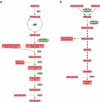Lipid metabolism and HCV infection
- PMID: 21994676
- PMCID: PMC3187597
- DOI: 10.3390/v2051195
Lipid metabolism and HCV infection
Abstract
Chronic infection by hepatitis C virus (HCV) can lead to severe liver disease and is a global healthcare problem. The liver is highly metabolically active and one of its key functions is to control the balance of lipid throughout the body. A number of pathologies have been linked to the impact of HCV infection on liver metabolism. However, there is also growing evidence that hepatic metabolic processes contribute to the HCV life cycle. This review summarizes the relationship between lipid metabolism and key stages in the production of infectious HCV.
Keywords: HCV; RNA replication; VLDL assembly; cholesterol biosynthesis; fatty acid biosynthesis; hepatitis C virus; lipid droplets; lipid metabolism; virus assembly.
Figures


References
-
- The Global Burden of Hepatitis C Working Group. Global burden of disease (GBD) for hepatitis C. J Clin Pharmacol. 2004;44:20–29. - PubMed
-
- Global surveillance and control of hepatitis C. Report of a WHO Consultation organized in collaboration with the Viral Hepatitis Prevention Board, Antwerp, Belgium. J Viral Hepat. 1999;6:35–47. - PubMed
-
- Di Bisceglie AM, Goodman ZD, Ishak KG, Hoofnagle JH, Melpolder JJ, Alter HJ. Long-term clinical and histopathological follow-up of chronic posttransfusion hepatitis. Hepatology. 1991;14:969–974. - PubMed
-
- Di Bisceglie AM. Hepatitis C. Lancet. 1998;351:351–355. - PubMed
Grants and funding
LinkOut - more resources
Full Text Sources

